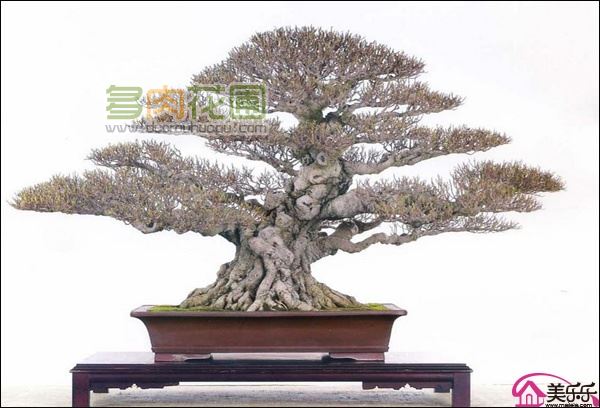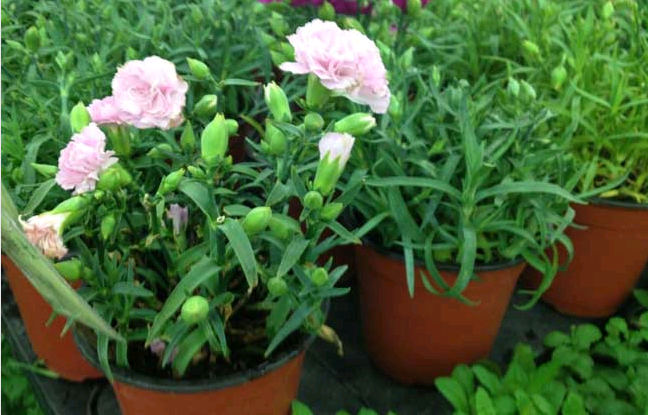How to cultivate old banyan bonsai?
Tree stump bonsai pay attention to old, but the wild old banyan stump is very limited. In recent years, through the cultivation of young trees and the increasing number of climbing and shaping, in order to make the stems and roots of young trees old, the following manual processing methods can be adopted:
(1) climbing aluminum wire. Climb the trunk with soft aluminum wire, when the aluminum wire will be trapped, release, change a position to continue climbing, so repeatedly, can make the trunk epidermis become rough, look old.
(2) cut dry to make scar. When the trunk is cultivated rapidly, the trunk is cut off continuously, and the cut gradually produces a healed wound, which makes the trunk segment short and many scars.
(3) induce the air root and fibrous root of the trunk to grow, and arrange the air root and fibrous root, and make them into a thousand roots, that is, the so-called "add dragon beard", to make the stump look old.
(4) carving scars. In the peak growth period of the stump, the bark is cut off with a sharp knife and cut to the xylem, or the xylem is dug into a hole in the trunk, and the carved part heals to form a scar.
(5) pruning to make scar. Cut off the extra thick branches on the trunk, which will produce swollen scars.
(6) percussion to cause tumor. Hit the base of the trunk locally with a hammer, so that the bark continues to divide and proliferate due to mechanical contusion, forming a tumor-like healing scar.
(7) Tigen exposed claws. Gradually lift the root to the surface of the soil to form a claw root, which is slightly struck with a hammer, making the surface of the root rough and giving people the feeling of "going through the vicissitudes of life".
How to cultivate old banyan bonsai?
How to cultivate old banyan bonsai?
Tree stump bonsai pay attention to old, but the wild old banyan stump is very limited. In recent years, through the growing number of young trees, climbing and shaping, in order to make the roots of young trees become old, the following manual processing methods can be adopted:
(1) climbing aluminum wire. Climb the trunk with soft aluminum wire, when the aluminum wire will be trapped, release, change a position to continue climbing, so repeatedly, can make the trunk epidermis become rough, look old.
(2) cut dry to make scar. Rapid cultivation of the trunk at the same time, constantly cut dry, cut off the mouth one by one to produce a new wound healing, so that the jade stem section is short and many scars.
(3) induce the air root and fibrous root of the trunk to grow, and arrange the air root and fibrous root to make the attached dry root, that is, the so-called "dragon beard", to make the stump look old.
(4) carving scars. In the peak growth period of the stump, the bark is cut off with a sharp knife and cut to the xylem, or the xylem is dug into a hole in the trunk, and the carved part heals to form a scar.
(5) scissors make scars. Cut off the extra thick branches on the trunk, which will produce swollen scars.
(6) percussion to cause tumor. Hit the base of the trunk locally with a hammer, so that the bark continues to divide and proliferate due to mechanical contusion, forming a tumor-like healing scar.
(7) Tigen exposed claws. Gradually unearth the root and form the claw root, which is slightly struck with a hammer, making the surface of the root rough and giving people the feeling of "going through the vicissitudes of life".
Banyan bonsai picture appreciation banyan bonsai culture method
Banyan bonsai with its natural shape and unique charm makes it suitable for display at home, office and public places. So how to raise banyan bonsai? How to raise it to help it grow well? Let's let the editor introduce it to you. The banyan tree itself is famous for its unique tree-shaped structure, luxuriant branches and leaves and huge crown. Therefore, it can become a unique artistic shape of potted banyan bonsai. The banyan bonsai takes the banyan tree as the material, through the method of pruning and pruning, after long-term careful cultivation, it has become a unique artistic potted plant.

The cultivation method of banyan tree has the following four important steps. When the banyan tree has plenty of light, it belongs to subtropical plants. It likes sunny, well-ventilated and warm and humid environments. Sexual tolerance to drought, tolerance to semi-overcast. Generally, it should be placed in a ventilated and transparent place, and the space humidity must be very adequate. if the sun is not enough, ventilation is not smooth, and there is no certain space humidity, it will lead to plant yellowing, dryness, and even diseases and insect pests, and finally death. two。 Properly watered banyan trees are planted in the basin, if they are not watered for a long time, the plants will wither due to lack of water, so it is necessary to observe in time and water according to the dry and wet conditions of the soil to maintain a certain amount of soil moisture. The method of watering is: pour until there is water seeping out from the drainage hole at the bottom of the basin, but not half of the water (that is, wet and dry on the top). When the soil turns white and the surface soil is dry, we will continue to water it for the second time. Be careful not to wait for the basin soil to dry before watering. Watering times are considered in terms of spring, summer, autumn and winter, that is, less in winter and spring and more in summer and autumn. 3. A little fertilizer banyan tree does not like fertilizer, apply more than 10 grains of compound fertilizer every month, pay attention to bury the fertilizer in the soil along the edge of the flowerpot, and water it immediately after fertilization. The main composition of fertilizer should be nitrogen, phosphorus and potassium. 4. Pruning process to have a good pot, of course, can not be separated from pruning. Wild piles become pile scenes, and pruning is a very important process. In the first year, we first cultivate its foundation, nourish its essence, erase only the wrong buds, and wait for the branches to grow thick and lignified in the second year before they can be pruned. However, it should be mainly cut, supplemented by binding, and the number of cuts should be once a year, but those who are strong and strong can be trimmed twice. The forks that grow from the short branches are stout and then pruned again. Over and over again, if it is properly pruned, a good bonsai will appear in your hand in less than four years. Note: northern winter banyan bonsai should be placed in the house, often watered, the most important thing is to maintain the wetness of the house, the pot must be deep enough, otherwise it is not easy to take root. There are many reasons for the loss of leaves in banyan bonsai, such as improper watering, lack of light, diseases and insect pests, etc., we should pay attention to the specific reasons, symptomatic treatment. Conclusion: the banyan bonsai culture method introduced by the editor above, do you remember clearly? In fact, the banyan bonsai culture method is relatively simple, the banyan root cortex is thick, it is easy to survive! You can try it! More Information | what does White Rose mean | Plant Anti-computer radiation | Geranium | Rhododendron Culture methods and precautions | Lavender florescence | Indoor foliage plants | Parthenocissus | Lilium foliage | efficacy and function of mint | Culture method of mimosa | | how to raise succulent plants | Osmanthus | gynostemma pentaphyllum | hand-made roses | efficacy and function of honeysuckle | Kumquat |
- Prev

How do carnations propagate and manage?
Carnations are generally propagated by cuttings. Cuttings are carried out in early spring. The third to fourth lateral buds in the middle of the branch were selected as cuttings, and the sprouting branches in the rhizosphere were the best. Cutting is more suitable when flower buds are formed. Cuttings should be cut immediately after cutting. On a cloudy day or in the morning. After cutting, the section at the base is stained with charcoal powder.
- Next

How to make the leaves of potted banyan trees shrink to enhance the viewing effect?
The ornamental value of the roots and stems of bonsai fig trees is extremely high, but the leaves are slightly larger, the leaves are about 3 cm wide and 4 cm long, and the average area of each leaf is 12.3 square centimeters, which is about 4 times larger than the average area of Indian fig leaves. According to this proportion, the leaves of Chinese fig trees are too large
Related
- Fuxing push coffee new agricultural production and marketing class: lack of small-scale processing plants
- Jujube rice field leisure farm deep ploughing Yilan for five years to create a space for organic food and play
- Nongyu Farm-A trial of organic papaya for brave women with advanced technology
- Four points for attention in the prevention and control of diseases and insect pests of edible fungi
- How to add nutrient solution to Edible Fungi
- Is there any good way to control edible fungus mites?
- Open Inoculation Technology of Edible Fungi
- Is there any clever way to use fertilizer for edible fungus in winter?
- What agents are used to kill the pathogens of edible fungi in the mushroom shed?
- Rapid drying of Edible Fungi

